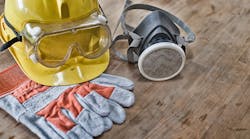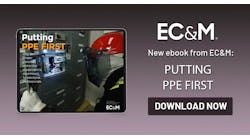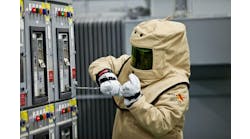Certain kinds of products are (when you calculate the ROI) a rip-off — and you should be happy they are.
Take homeowner’s insurance as an example. You pay premiums for decades, but never file a claim. That is much better than “getting your money’s worth” because your house burned down. The insurance is there in the unlikely event all else fails to prevent the fire (or whatever you are insuring against).
So, we install AFCIs in our homes, discard damaged extension cords, don’t set space heaters near combustibles, and do the basic housekeeping that prevents accumulating an excess fuel load. Even with these and other precautions, the unexpected can happen. Few of us would consider it wise to skip the insurance (something you can do if you don’t carry a mortgage).
When we redo the math after factoring in the risk and severity of a catastrophic event, it makes perfect sense to pay for something we hope we will never use. Generally, personal protective equipment (PPE) products fall under a similar logic. The fact that you used it (not merely wore it) usually means there was either a safety failure or an unforeseen event.
Fall protection in the form of a harness and lanyard is an example. If you could create a work environment where falls don’t happen, you’d make the fall protection gear an apparent “waste of money.” Creating such an environment is difficult, so falls do happen. But it’s better to “wastefully” discard old gear than to get every penny’s worth from it.
After a few hard falls, harnesses and lanyards should be discarded regardless of their apparent condition. What if you discard the PPE while it still has a hard fall or two left in it? Did you fail to get your money’s worth? No, because the gear was reliable while you had it in service, and that is what counts. It’s insurance against a safety failure or unforeseen event.
It is always better to prevent the hazard from occurring than to rely on PPE when it does. One reason is PPE, like anything else, can be incorrectly used, fail, or be circumvented.
For example, every lawn mower owner’s manual has warnings to wear safety glasses and hearing protection even though modern mowers are designed with shields to stop projectiles. The smart user inspects the yard for rocks and bottles before mowing, because it is possible for a rock or glass shard to bounce off of a hardpan on a dry summer day and come up behind your safety glasses or just whack your shin.
Minimizing reliance on PPE
How can we minimize the work our PPE has to do and thus minimize our reliance on PPE? One method for doing that is based on NFPA 70E, Annex F, Table F.3. The table is titled “The Hierarchy of Risk Control.” It contains six levels — in order from the first line of defense to the last line of defense. These are:
- Elimination
- Substitution
- Engineering controls
- Awareness
- Administrator controls
- PPE
The first three levels of control tend to present the most opportunity for “wasting” your PPE expenditures. Let’s look at those three levels and three types of PPE:
- Fall protection
- Respirators
- Safety glasses
It’s important to note that minimizing reliance on PPE doesn’t mean you don’t use it. It’s there as insurance because anything can happen. Similarly, you maintain that homeowner’s insurance policy even though you hope you never collect.
Elimination
Suppose you have a PM that requires climbing 15 ft above grade to take voltage readings on a motor. The task is made easier because the motor overloads are up there; you don’t have to untape any motor leads to take the readings. You could eliminate the climbing task by relocating the motor overloads to be accessible from grade level.
This principle applies to any electrical measurement tasks at elevation; bring the testing points to grade level and have testing ports (or similar) there. You’ve now eliminated the climbing part of this task.
Coring into walls and floors creates large amounts of silica dust. To eliminate the need for a respirator, choosing a different routing path might work (e.g., go around the wall instead of through it). For green construction, ensuring the openings are made when the wall is poured also eliminates the need for a respirator because it eliminates the need to core into the wall.
Fabrication tasks require safety glasses. Field fabrication (such as boring holes in cabinets) can put significant eye-unfriendly particles into the work area or eject them into the eye. Prefab eliminates the “need” for safety glasses for this aspect of the job. This doesn’t mean you wear safety glasses any less while on the job, it just means they have one less danger to protect you from.
Substitution
Substitution reduces the magnitude of the risk. For example, you replace a 120V control circuit with a 24V one (same example used in Table F.3). There is seldom a substitution solution for fall risk, since a fall from 40 ft is just as deadly as a fall from 200 ft. Generally, substitution will depart a bit from Table F.3 to eliminate rather than reduce a fall hazard.
Earlier, we used the solution of moving the test points to be accessible from grade level to eliminate the climbing part of a measurement task. Substitute automation for manual measurement, and you eliminate the task entirely, not just the climbing part of it. For example, use a local panel meter or a power monitor instead of taking readings manually. If you need motor vibration data, install motor vibration sensors.
Circumstances arise where the choice of elevated equipment location (and thus landing spots) can be significant. For example, it’s better to fall onto a foot traffic aisle in a factory than to fall into the scrap grinder; locating a bus on this I-beam versus that one can matter. It can also matter whether the location is accessible to a scissor lift instead of a ladder climb.
How would substitution work for reducing (or eliminating) dangers that respirators protect against? We have an excellent example in the silica dust protection area. Many years ago, only a few employers cared whether their employees breathed in silica dust.
As more started to care, pressure built on two fronts. One was to get OSHA to adopt silica dust regulations based on the rules these employers were using. That was ultimately successful. Another was answered by manufacturers, mostly in response to the growing number of employers wanting to reduce or eliminate silica dust hazards. Dust collection devices began to proliferate the market — and not just retrofit devices. It became common to incorporate dust collectors into drills and saws. Substituting one of these tools (or a retrofitted one) in place of one with no dust collection abilities has a dust reduction effect like the shock reduction effect of replacing 120V control circuits with 24V control circuits (per the example in Table F.3).
Some manufacturers went far beyond merely reducing the dust. For example, you can now buy a coring device that puts a 4-in. hole into a cement wall with zero dust emission into the operator space. Presumably, this also eliminates the “need” for safety glasses (but keep the lawn mower example in mind).
Engineering controls
This typically involves installing barriers between the danger and the worker. A guardrail works for fall hazards, and ventilation often reduces or eliminates respirator requirements. Welding screens eliminate the need for everyone in the area to wear a welding mask to protect their eyes.
Rather than think of engineering controls to eliminate safety glasses, think of ways such controls can render safety glasses less necessary. For example, installing the little plexiglass shields on a grinder puts a “pre-safety glass” close to the source of the eye hazard. Using a jig to properly secure the work for a saw can prevent a severed finger from hitting you in the eye (think about that one for a minute).
Try to waste money on PPE
Which makes more sense? Having an environment so dangerous that fall protection PPE does a “catch” 16 times per week or an environment so safe that fall PPE gets discarded due to age alone? We go back to the homeowner’s insurance example. We all hope we never have to collect and “get our money’s worth” on that insurance.
If you combine elimination, substitution, and engineering controls with the goal of minimizing reliance on PPE, odds are you won’t “get your money’s worth” from the PPE. But you will get your money’s worth from the investment that got you to that point because the work environment will be inherently safer. The money you “waste” on PPE this way is more than compensated for by the benefits of moving the protection closer to the hazard rather than closer to the people you intend to protect.
Mark Lamendola is an electrical consultant based in Merriam, Kan. He can be reached at [email protected].




